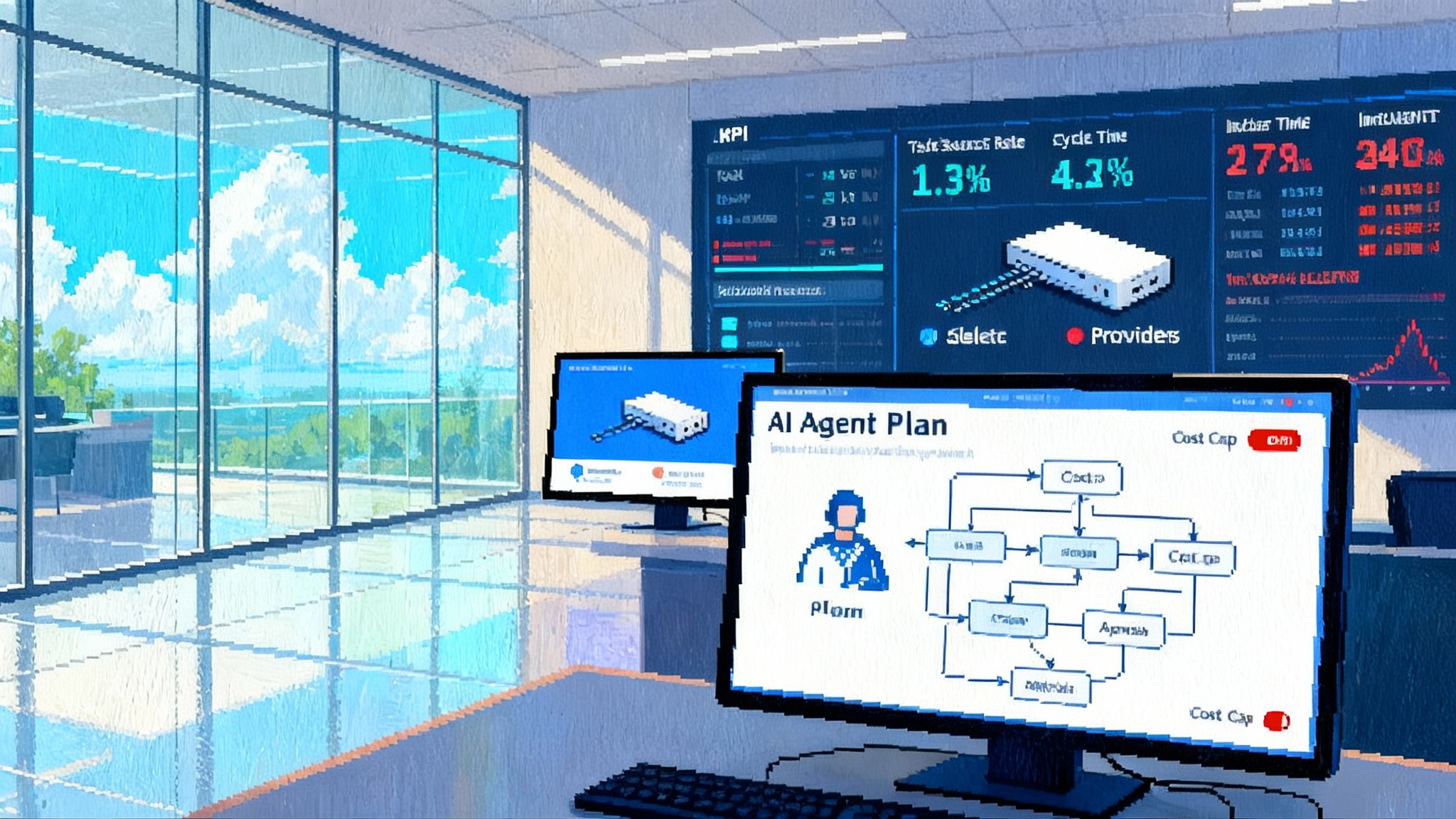Citi’s AI Agent Pilot Is the Bank-Grade Tipping Point
In late September 2025, Citi began piloting autonomous AI agents inside Stylus Workspaces for 5,000 employees. Here is what changed, why multi-model orchestration matters, and a rollout blueprint with KPIs, controls, and incident playbooks any regulated enterprise can copy.

The moment that changed the tone of AI in regulated industries
In late September 2025, Citigroup began piloting autonomous AI agents inside its employee platform, Stylus Workspaces, initially opening access to about 5,000 workers. The shift moves beyond everyday copilots to task-owning agents that plan, execute, and verify multi-step work with minimal hand-holding. Public details emphasize multi-model underpinnings and safeguards that prioritize control and traceability over raw speed. This is the moment regulated industries have waited for because it shows a path from experimentation to accountable production at scale. For context, see Citi agent pilot details.
The frame is bigger than one bank. When a global systemically important institution moves from copilots to true agents, it sets a pattern others can adopt. The question is no longer if agents will enter regulated workflows, but how to do it in a way that satisfies boards, auditors, and supervisors while delivering measurable business value.
From copilots to agents, in plain language
Copilots assist a human who remains in the driver’s seat. Agents take a goal and own the steps. They plan, gather data, call tools, check their own work, and decide when to ask for help.
- You ask for a reconciled view of a client’s exposure across multiple systems. The agent discovers sources, pulls entitlements-appropriate data, normalizes schemas, computes the view, and posts an audit trail.
- You request a draft control test plan aligned to specific policy clauses and regulatory guidance. The agent composes a plan, cites the control library, and routes it for approval with evidence links ready.
Copilots reduce friction. Agents reduce handoffs. In regulated environments, handoffs are expensive and risky because they multiply latency and create opaque responsibility. If we can keep oversight while compressing handoffs, we change the operating model.
What Citi is actually piloting
Citi’s pilot matters because it introduces agents as first-class workers in the bank’s own environment. Reporting indicates Stylus Workspaces can orchestrate multiple models, including options like Gemini and Claude, and wrap them in controls suitable for bank operations. The initial cohort of roughly 5,000 users is large enough to generate meaningful usage and cost patterns, yet bounded enough to preserve tight governance.
Early bank use cases are pragmatic:
- Research and synthesis at policy grade
- Operations automation for control testing and reconciliations
- Developer productivity for internal platforms where agents own steps rather than suggest snippets
The common thread is that each use case either reduces cycle time for already governed work or increases the quality and auditability of outputs that matter to regulators and internal audit.
Guardrails that make agents production-safe
Getting agents into a bank is not about more power. It is about bounded power. Four categories of guardrails separate a scalable pilot from a risky demo.
- Cost caps that fail safe
- Per-task and per-session dollar limits enforced at the platform level, with escalation required to breach a cap
- Team and application budgets that refresh monthly and can be throttled daily
- Hard-stop policies for infinite loops and runaway tool calls
- Human-in-the-loop by design
- Approval checkpoints based on risk tier and role
- Dual control for sensitive actions such as changing a control definition or production configuration
- Escalate early when confidence or coverage drops below a threshold
- Auditability you can show to an examiner
- Immutable event logs with full lineage of prompts, plans, tool calls, data sources, and outputs
- Deterministic replays for samples using model snapshots
- Evidence packaging that travels with every material output
- Data governance that travels with the task
- Classification-aware routing so sensitive data stays in approved enclaves
- Automatic redaction and tokenization of PII with logged exceptions
- Policy as code evaluated continuously at runtime
These four categories turn a press-worthy pilot into a platform the business can trust through audits and examinations.
Why multi-model orchestration matters more in banks
Agent performance is a portfolio problem. No single model is best across every task, sensitivity level, and price point. Banks need a router that can:
- Pick the right model for the job based on task class, sensitivity, latency targets, and budget
- Blend models within a task, using a fast model for planning and a high-accuracy model for reasoning
- Respect data gravity and legal boundaries with in-enclave options where needed
- Continuously learn from measured outcomes with A/B tests, shadow runs, and challenger models
For a bank, orchestration is also about risk isolation. If a vendor model regresses or policy mismatches occur, you can route around it without pausing the program. For additional context on enterprise strategy, see our multi model enterprise playbook and how the 1M-token context race is reshaping agent design.
The bank-grade cost and risk calculus
The economics of agents are about total cost of ownership and avoided risk, not just token price. Run this calculus before and during rollout.
Direct and indirect costs
- Inference and orchestration across planning, tools, and verification
- Platform engineering for routing, policy enforcement, logging, privacy, and sandboxing
- Model evaluation and validation with red teams and labeled datasets
- Human oversight for approvals, reviews, and escalations
- Incident management, including communications with regulators if needed
Value levers to quantify
- Cycle time reduction on governed workflows
- Quality lift and lower rework via blind sampling
- Capacity relief for first-line teams and developers
- Risk reduction through fewer missed control breaks and higher documentation completeness
Regulated-sector risk scenarios to model
- Hallucinated citations in policy or regulator-facing documents
- Data leakage across boundaries
- Silent failure in a critical workflow
- Vendor dependency shock
For security posture and failure containment, review the emerging agent hijacking risk and ensure mitigations are integrated into planning, verification, and runtime policy.
Tie this calculus to supervisory expectations. In banking, model-governed AI should align to the Federal Reserve’s SR 11-7 guidance on model risk management. Treat agents as models plus process, with inventories, documentation, independent validation, and ongoing performance monitoring.
A concrete rollout blueprint for Q4 2025
Phase 0: Readiness and scope
- Define the first ten high-value, low-blast-radius tasks with clear success criteria
- Establish the control plane for orchestration, policy, logging, cost caps, and human-in-the-loop
- Create an evaluation harness covering safety, policy adherence, factuality, and task success
- Map data classes to model options with documented boundaries
Phase 1: Limited production with tight controls
- Roll out to 500 to 1,000 named users across two functions with conservative cost caps
- Stand up a dedicated incident desk with a 24 by 5 rotation and real-time alerts
- Start weekly governance with risk, audit, legal, and platform leads
- Build the audit evidence pipeline that packages outputs, sources, approvals, and policy checks
Phase 2: Scale by task class, not by team
- Expand to new task classes only after passing quality, cost, and incident thresholds
- Introduce challenger-based routing with shadow runs
- Delegate budget control to product owners with central guardrails and a cost dashboard
- Promote cross-function reuse with task templates and pre-wired controls
Phase 3: Optimize and harden
- Tune for price performance by shifting routine steps to lighter models
- Automate more approvals once policy alignment hits near-perfect adherence under sampling
- Run exit drills for vendor outages with internal or alternative model fallbacks
- Prepare for external examination with inventories, validation reports, monitoring, incidents, and evidence bundles
KPIs that matter
- Task success rate without escalation
- Quality error rate from sampled outputs
- Cycle time delta versus baselines
- Cost per task and budget variance
- Control adherence via evidence bundle completeness
- Incident rate and mean time to resolve by severity
Controls to document and test quarterly
- Access and entitlements for agent tool use with separation of duties
- Model change management with pre-deployment evaluation and rollback
- Data residency and classification routing rules with automated tests
- Logging integrity checks and retention policies aligned to records requirements
- Human oversight thresholds with sampling plans and reviewer effectiveness metrics
Incident response plan you can practice
- Clear taxonomy: data boundary breach, cost overrun, policy non-adherence, quality regression, vendor failure
- Fixed triggers: immediate pause and escalation for material client communication errors or boundary crossings
- Runbooks with named roles: incident commander, communications lead, risk liaison, model owner, data owner
- Forensics and reporting: freeze logs, preserve model snapshots, compile evidence bundles, prepare notices if thresholds are met
- Recovery steps: kill switch, fallback to manual or non-agentic workflow, validated hot-fix, and staged re-enable
The architecture that makes this work
- Identity and policy: Central IAM with fine-grained scopes for agent actions and data access, enforced by a policy engine
- Task router: Classifies the task, chooses the model set, and sets cost and oversight thresholds
- Planning and tools: Agent planner that selects from a curated tool catalog running in sandboxes with signed inputs and outputs
- Verification layer: Separate model or rules engine that checks citations, computations, and policy alignment before release
- Evidence builder: Bundles sources, checks, approvals, and hashes into a tamper-evident package
- Observability: Metrics, traces, and alerts across models, tools, cost, and errors for operations, risk, and finance
This separation lets you swap models without rewriting controls and gives auditors a map they can follow. It also builds an on-ramp for internal models and vendor diversity without creating policy drift.
Common failure modes and how to avoid them
- Scaling by headcount rather than by task class
- Treating agents as a chat window instead of a structured workflow
- Over-indexing on one model family without challenger runs
- Neglecting price performance and planner limits
- Weak human oversight that turns approvers into rubber stamps
What to watch next
- Expansion to client-facing workflows with stricter dual control and post-fact monitoring
- In-enclave deployments of reasoning models for data-sensitive work in risk and finance
- Inter-agent collaboration patterns where one agent plans and another verifies
- Formalization of agent governance under existing model risk frameworks, including inventories, validations, and challenger testing
The arc is clear. Copilots lowered the friction of knowledge work. Agents, properly bounded and audited, lower the total cost and risk of running critical workflows. Citi’s pilot shows that a bank can move from exploration to accountable execution without waiting for perfect standards or one size fits all platforms. With a multi-model core, policy-first design, and a rollout plan that treats cost and risk as first-class metrics, regulated enterprises can move now, not next year.








